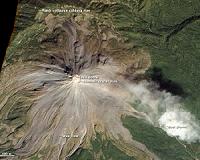 |
Bonn, Germany (SPX) Jan 31, 2011 Traffic monitoring from space, day and night, from more than 500 kilometres up above; is that possible? Indeed it is! In fact, it has been demonstrated several times in the past - once with the Shuttle Radar Topography Mission (SRTM), and again with TerraSAR-X. The traffic processors used with SRTM and TerraSAR-X were and are still subject to considerable limitations. To determine vehicle speeds and locations, a database of the road network is required. There is no reliable way of dealing with vehicles moving on open land or on unmapped roads. Areas that contain many parallel streets are also problematic. At the DLR Microwaves and Radar Institute, a special traffic processor for the TerraSAR-X/TanDEM-X satellite constellation has been developed, which is not subject to the limitations mentioned above. There is no need for a road database or any other prior knowledge. Off-road vehicles and ships at sea can be detected clearly and with high accuracy. The traffic processor combines the data recorded by TerraSAR-X and TanDEM-X at different times. To achieve the best performance, the distance between the two satellites is required to be 20 kilometres. The commissioning phase of TanDEM-X was ideal for demonstrating the performance capabilities of the traffic processor. During this phase, the two satellites were positioned precisely 20 kilometres apart, before eventually moving into close formation.
How does the radar differentiate between stationary and moving objects? This difference in Doppler frequency means that moving objects shift from their actual position when depicted in a radar image. This means that vehicles might appear to be quite some distance from the road where they actual are: "It's in the ditch!" some might assume at first glance. But this 'ditch' could be several hundred metres away from the actual road, depending on the speed of the vehicle. So, it can be hard to determine the true position of vehicles and clearly assign them to the road that they are travelling on. This is where the traffic processor comes in. Its purpose is to detect the vehicles and their actual positions and speeds with high precision.
How did TerraSAR-X measure vehicle positions and speeds on its own? As mentioned before, among other things, there are problems with areas that include densely populated zones with a number of parallel streets, which make it difficult to assign vehicles to the correct road. In the worst-case scenario, if TerraSAR-X evaluates just the interferometric phase between its two antenna halves, the results can be several hundred metres out. The main reasons for this are phase noise and interference from stationary objects.
On what principle does the new, more powerful TerraSAR-X / TanDEM-X traffic processor operate? For example, in the illustration to the right, a vehicle or ship is depicted in different 'incorrect' positions in the two images, as it moved in the interval between the two satellite recordings and its true position changed. The displacement in the image depends on the speed of the target and how far apart the two satellites are. The difference between the images can be measured with high precision and this means that the vehicle or ship's actual position, its speed, direction and even its acceleration can be calculated accurately. Preliminary results from the commissioning phase show that the speed estimation error was less than one kilometre per hour and the average position estimation error was about 20 metres. These figures are quite impressive; no other radar satellite system has ever achieved this accuracy, particularly without the use of a road database! Obviously, we have to spend the next few weeks evaluating more recordings from the commissioning phase to statistically confirm the estimation accuracy, and we have to work on optimising the traffic processor. Only then will we be able to finalise the verification phase.
What exactly does the new traffic processor provide as output? The detected ships are depicted as coloured symbols in the image. The positions of the symbols represent the true positions of the ships. The user can click on a symbol to open a window showing all the relevant information about the ship (shown on the left of the illustration below). In this example, the window also includes Automatic Identification System (AIS) reference data, which are used to verify the performance of the traffic processor. There are other output formats available in addition to KML, which enable a more detailed, automated traffic assessment and data analysis process, by a Traffic Management Centre, for example. The radar data taken from TerraSAR-X and TanDEM-X were pre-processed with the versatile TAXI processor (Experimental TanDEM-X Interferometric Processor) developed at the DLR Microwaves and Radar Institute. To verify the performance of the traffic processor, AIS data kindly provided by Stephan Brusch and Susanne Lehner of the DLR Remote Sensing Technology Institute was used.
Share This Article With Planet Earth
Related Links DLR Microwaves and Radar Institute Earth Observation News - Suppiliers, Technology and Application
 Eruption Of Colima Volcano
Eruption Of Colima VolcanoWashington DC (SPX) Jan 28, 2011 Colima Volcano, Mexico's most active, has been erupting since 1998. The eruption began with several months of earthquakes beneath the volcano, followed by explosions and rockfalls at the summit lava dome as it began to grow. Dome growth was accompanied months later by a series of lava flows which cascaded down the southwestern flank of the mountain, stretching up to 3,100 meters (10,000 fe ... read more |
|
| The content herein, unless otherwise known to be public domain, are Copyright 1995-2010 - SpaceDaily. AFP and UPI Wire Stories are copyright Agence France-Presse and United Press International. ESA Portal Reports are copyright European Space Agency. All NASA sourced material is public domain. Additional copyrights may apply in whole or part to other bona fide parties. Advertising does not imply endorsement,agreement or approval of any opinions, statements or information provided by SpaceDaily on any Web page published or hosted by SpaceDaily. Privacy Statement |